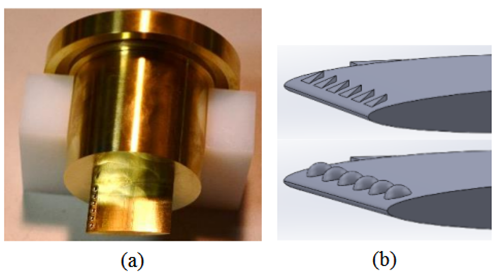Passive Control of Unsteady Cavitation on a Hydrofoil
Involved scientists
Dr.-Ing. Ebrahim Kadivar
Prof. Yuka Iga
Prof. Dr.-Ing. Bettar Ould el Moctar
Project description
Cavitation is a process of liquid evaporation, bubble or vapor sheet formation, and further collapse of vapor structures, which plays an undesirable role in many industrial applications. In ship technology and hydraulic machinery, cavitation usually occurs nearby the surface of a ship propeller and rudder, impeller blades in a pump, and distributor vanes and runner blades in a hydroturbine and causes various destructive effects such as vibrations, erosion, and noise and performance decline in immersible bodies. Many studies have been conducted using a hydrofoil for understanding of the characteristics of cavitation and dynamics of cavitation formation. This research is aimed at an experimental investigation of passive methods to control cavitation on a hydrofoil. For this aim, several types of hydrofoils with different vortex generators such as microramp and hemispheretype of vortex generators are manufactured in accordance with Kadivar’s previous numerical works. Different cavitating regimes such as unsteady cloud cavitation and supercavitation at various angles of attack of the hydrofoil are studied in this project. To analyze the effect of cavitation control methods on the cavitation dynamics, a highspeed imaging method is used to explore the spatial patterns and time evolutions of cavitation structures. In addition, a pressure transducer is used to record and analyze the pressure pulsations due to the collapse of the cavities in the hydrofoil wake region. The suppression of unsteady behavior of the cloud cavitation, the stabilization of the supercavity at the supercavitating regime and the reduction of the amplitude of the pressure pulsations has been expected to achieve longer operating life and high reliability.
Sample results

Fig. 1: a) The photo of the NACA 16012 hydrofoil with the distributed hemispherical vortex generators on the suction side of the hydrofoil near the leading edge. b) The shape of the micro-ramp vortex generators and hemispherical vortex generators mounted on the hydrofoil surface near the cavitation inception location.

Fig. 2: Photograph of the side-view of the super-cavitation formation on the NACA 16012 hydrofoil surface for the case a) without miniature vortex generator and b) with miniature vortex generator. The flow direction is from left to right.
Publications
- Kadivar, E., Ochiai, T., Iga, Y., el Moctar, O., “An experimental investigation of the cavitation control on a hydrofoil using hemispherical vortex generators”, In preparation 2021.
- Ochiai, T., Kadivar, E., Sugaya, K., Okajima, J., Iga, Y. “Active and Passive Control of Unsteady Cavitation on a Hydrofoil”, 17th international conference on fluid dynamics, Sendai, Miyagi, October 2020
Project duration: April 2020 - April 2023Funding
-
Institute of Fluid Science of Tohoku University
Project partner
-
Tohoku University

